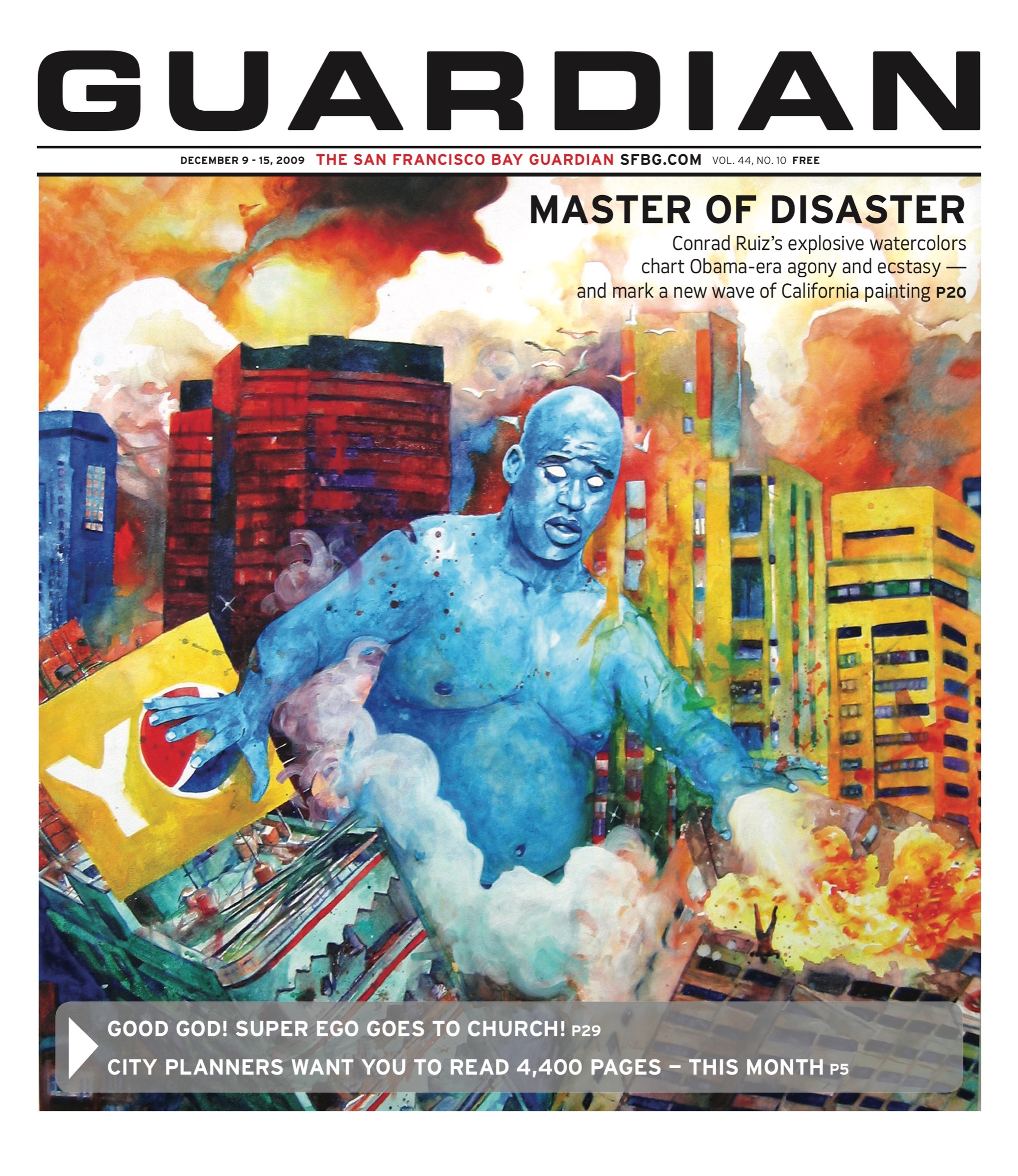a&eletters@sfbg.com
VISUAL ART "Amish Abstractions," the de Young Museum’s exhibition of 48 quilts made primarily by anonymous Amish girls and women, gains its conceptual interest from the unusual pairing of the words Amish and abstraction.
The collectors of these quilts were initially drawn to them by their similarity to works by 20th century abstract artists. While the attendant monograph asserts this juxtaposition several times, within the show itself you only get a disclaimer by curator Robert Shaw. "Many have compared the abstract geometry of Amish quilts to the works of acclaimed modernist painters such as Paul Klee, Piet Mondrian, Josef Albers, Ellsworth Kelly, Clyfford Still, Mark Rothko, and Victor Vasarely," he writes. "Any such comparisons are problematic, however, because they are built on visual coincidence, not on any documented historical connection or known influence in either direction."
The collectors behind "Amish Abstraction," Faith and Stephen Brown, add Frank Stella and Sol LeWitt to such a list. Still, with the exception of Albers, and to a lesser degree Stella and Vasarely, the visual coincidence feels forced. As Shaw points out, it’s a big leap from the ideals of Abstract Expressionism to the ideals of Amish culture: submission to a masculine God, submission to husband and father, humility, community. We are told by the exhibition notes that the quilts are "individual and expressive" and "contradict our preconceptions of Amish society," but there is little exploration of how, why, or where this might be the case within in a culture that restricts both self-expression and self-representation.
Having actually slept under frumpier and more polyester Amish quilts — ones my Amish grandmother and cousins made — I came to this show with low expectations. The quilts, however, are stunning. The concentration of geometric patterns, optical illusions, and bright colors create an energy in the room that feels anything but Amish. The quilts suggest extravagance, hedonism, and the revolt of the body against whatever abstract principle might be crushing it.
It certainly seems that these Amish women might have intuited aspects of Albers’ color theory. Their optical illusions are considerably more restrained than Vasarely’s, and the palette considerably more subdued than Stella’s. Few rainbows here; the Amish women favored black backgrounds and less busy juxtapositions that allow a sense of calm to pervade the constant movement suggsted by the patterns. Yet even the names of some of the patterns are hallucinogenic: Crazy Quilt, Jacob’s Ladder, Crosses and Losses, Old Maid’s Puzzle, Stairway to Heaven, Broken Star, Crazy Star, Sunshine and Shadow.
The radiance and abstraction of the quilts in "Amish Abstractions" suggest transcendence, deep spiritual harmonies, and the pleasures to be found in egolessness. In our own culture, with its pathological celebration of self and merging of personality and advertising, the idea of dispensing with the ego altogether might seem healthy. As Shaw says, "[The quilters] proceed from the place modern artists sought to find, and they reflect the stoic quietude of the Amish — their rich interior world of spiritual calm, shared values, and mutually beneficial self-denial."
The curators do an excellent job of elucidating, in very specific ways, the relationships between Amish and non-Amish communities, and the relationships between quilting patterns and specific local Amish traditions. They discuss the evolution of these specific traditions, but by restricting the quilts on display to the period from 1880 to 1940, they have trapped the Amish in the past, before the widespread use of synthetic fabrics or the "discovery" of Amish quilts by the art market.
Suggesting that historical specificity doesn’t apply to the timeless Amish, the large blow-up photographs throughout the exhibit of Amish children playing and Amish men building barns freeze the Amish in a different past. The photographs date from the 1980s, before the disappearance of affordable farmland sent young Amish men into factories, and before the Amish brand was tainted by meth-fueled megaparties of Amish kids on rumspringa and reality TV shows about corrupting "the innocent."
Since the 1930s, the major function of the Amish, for Americans in general, has been to represent an innocence the rest of us have supposedly lost. America, like the Amish, is imagined to have once been peaceful, rural, white, and untroubled by introspection. But surrounded by the bold colors and intricate stitching of "Amish Abstractions," it is easy to imagine that the Amish women who created them were secret sensualists or feminist mystics. If I didn’t know better, I’d guess they were created by revolutionary cells, possibly lesbians, who drank mushroom tea and let their hair out of their bonnets while their men were out working the fields.
But I do know better. My Amish grandmother was a young woman in Ohio during the 1930s, and so it is possible, although not likely, that she had a hand in one or two of the quilts on display. She left behind a written record of her life, condensed from diaries, a litany marked by births, weddings, and deaths, barns struck by lightning ("There was nothing to do but let it burn …"), accidents and near-accidents, bedbugs and prayer, dead children and epidemics of diptheria, influenza, whooping cough, measles, and delirium. This record is more than 100 pages long, and at times incredibly detailed about trips taken, people visited, and beets canned. Yet three years pass in a single paragraph which begins, "In the summer of 1945 I had a nervous breakdown." My father remembered little about his mother’s "nervous breakdown," but he thought she had probably been given some tranquilizers.
For the Amish, what a person might feel or want is never removed from what the community demands, from the work to be done, and from theological doctrine. Whether this constitutes spiritual calm and mutually beneficial self-denial or deeply oppressive self-abnegation is another question.
AMISH ABSTRACTIONS: QUILTS FROM THE COLLECTION OF FAITH AND STEPHEN BROWN
Through June 6, 2010
de Young Museum
50 Hagiwara Tea Garden Drive
Golden Gate Park, SF
(415) 750-3600

